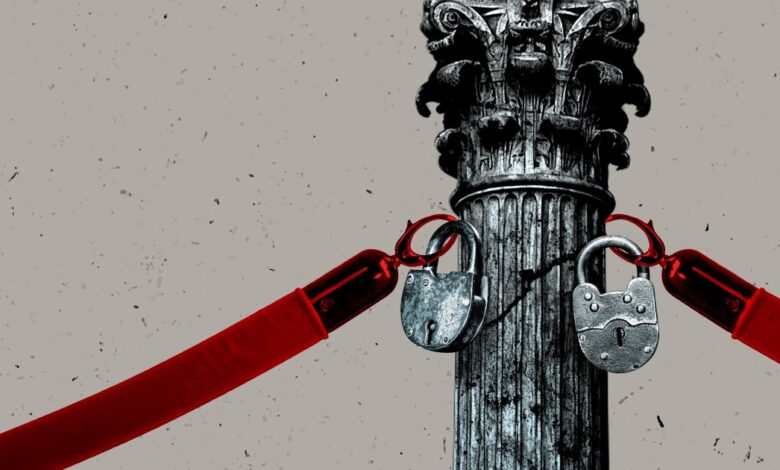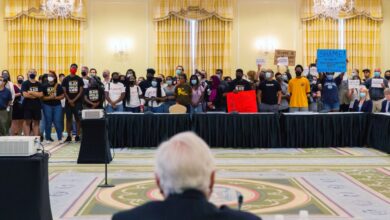Race-Conscious Admissions Is Gone. Will an End to Legacy Preferences Follow?

[ad_1]
Since the Supreme Court struck down race-conscious admissions last month, the pressure on colleges to stop giving the children of their alumni and biggest donors a leg up in admissions decisions has picked up. To anyone concerned that a degree from a selective institution will now become even more elusive to Black, Native, and Latina/o students — and who is looking for ways to lessen the many advantages white, wealthy applicants already have — legacy and donor preferences look like low-hanging fruit.
Will colleges respond? Since the ruling, none have announced they’ll stop using the controversial practice. Whether they’ve done so quietly, or plan to, is another question.
Admissions preferences for legacy applicants and the children of donors have been unpopular for years. The practice was known, and has been the subject of journalistic exposés and messy scandals. But how it worked remained hazy until the race-conscious admissions trial against Harvard College — one of the two cases accusing colleges of discrimination against Asian American applicants that were just decided by the Supreme Court. The trial forced Harvard to put the minutiae of its admissions process into the public record.
One analysis of the college’s admissions data, performed by the economist Peter Arcidiacono, who testified against Harvard, showed that the admission rate for athletes, legacies, the children of university employees, and donor children plus other VIPs on a “dean’s interest list” was over 30 percent, while the typical admission rate was 5.5 percent. The data was collected during the trial and included the Classes of 2014 to 2019. Data showed the vast majority of the legacy admits were white. (About one-third of Harvard undergraduates are white.)
Numbers like that have drawn public condemnation and some action. Hours after the Supreme Court’s decision, President Biden announced in a speech condemning the ruling that he was “directing the Department of Education to analyze what practices help build a more inclusive and diverse student bodies and what practices hold that back, practices like legacy admissions and other systems that expand privilege instead of opportunity.”
A few days later a coalition of advocacy groups filed a complaint with the U.S. Department of Education against Harvard, alleging that legacy and donor preferences overwhelmingly benefit white, affluent applicants and disadvantage nonwhite applicants. Drawing from the Supreme Court’s ruling, the organizations argued that the practice was discriminatory and illegal.
This decision has fundamentally set the stage for a lot more challenges. It’s going to be coming from all sides.
“Generation after generation of students of color are excluded from educational opportunities,” as a result of legacy and donor preferences, said Iván Espinoza-Madrigal in an interview. He is the executive director of Lawyers for Civil Rights, which filed the complaint.
Espinoza-Madrigal added that Harvard is far from alone in considering legacy and donor status. While the groups have not looked at other colleges’ policies yet, he said they believe it is critical for all institutions to eliminate the practices. He sees the complaint, as well as Biden’s comments, as a “unique opportunity for the Department of Education to conduct a thorough probe.”
Though they are unpopular, legacy preferences have persisted at selective institutions, which are a minority of higher education as a whole. About half of the four-year colleges that completed the common data set considered legacy status in 2020, according to a 2022 report by Education Reform Now, a group dedicated to improving public education. Of the 64 colleges that admit less than a quarter of applicants, 80 percent gave children of alumni an advantage in admissions, according to the report.
But the report’s author, James Murphy, deputy director of higher education policy, told The Chronicle that some colleges had dropped the practice in recent years. In many cases, he said, they were state flagships that did so quietly. Murphy saw that finding as evidence that the practice is not intractable.
The Johns Hopkins University is one institution that stopped considering legacy status — at first without telling anyone. In 2020, the university’s president, Ronald J. Daniels, told The Chronicle that Johns Hopkins had been gradually phasing out legacy preferences for about a decade. The incoming freshman class dropped from 12.5 percent legacy students in 2009 to 3.5 percent in 2019. At the same time, the proportion of students eligible for Pell Grants grew from 9 percent to 19.1 percent.
Daniels said in 2020 that the elimination of legacy preferences was only one of several changes that helped bring more socioeconomic diversity to the freshman class. Expanding financial aid and changing how the university marketed to students also contributed.
“But the termination of the program gives more space for the achievement of those other goals,” he said of legacy preferences.
‘You Rack Up $300,000’
So why haven’t more selective colleges followed suit? Campus leaders might be philosophically on board. Only 12 percent of admissions directors who responded to an Inside Higher Ed survey agreed that institutions should grant preference to legacy applicants.
“There are very few college presidents that if you gave them truth serum, wouldn’t tell you that they would like to get rid of legacy admissions,” said Holden Thorp, the former chancellor of the University of North Carolina at Chapel Hill and former provost of Washington University in St. Louis, both of which consider alumni affiliation in admissions. “There’s no moral argument for it.”
Generation after generation of students of color are excluded from educational opportunities.
The main case for it, Thorp said, is financial. Legacy students’ families can often pay full tuition. Admissions officers also have more confidence that if they’re admitted, they’ll attend. And sometimes such a family will send several children to the university in question.
“If you can just keep that family continuing to send people to your high-priced university, you rack up $300,000 every time it happens,” said Thorp, a chemistry professor at George Washington University and editor of the Science group of journals. Universities can then use that money to help pay for their financial-aid programs.
Still, that does not explain why the few dozen colleges with multibillion dollar endowments, who fund or could fund need-blind admissions programs, do not abandon the practice.
Some leaders have argued that getting rid of legacy and donor preferences would not actually do much to make selective college admissions more equitable. The children of alumni of those colleges have other built-in advantages — access to top schools, test-prep classes, and extracurricular activities, to name a few — that will earn them admission, if not to a parent’s college, then somewhere similar.
“If legacy status no longer matters, an Ivy League university will simply admit the children of another Ivy’s alumni,” Catharine B. Hill, the former president of Vassar College, argued in a 2021 Chronicle essay. Hill wrote that if colleges really want to be more equitable, they should spend more on financial aid and admit more students who cannot afford to pay full-freight.
That is probably something selective colleges are considering as they scramble to comply with the Supreme Court’s ruling. But first, they’re faced with determining which policies are legal. Confusion over whether the decision affects scholarships and financial aid aimed at nonwhite students underscores the ruling’s wide-reaching effects. In Missouri, the attorney general told public universities that they should “immediately cease their practice of using race-based standards to make decisions about things like admissions, scholarships, programs, and employment.”
The Biden administration is set to issue “resources to colleges and universities addressing lawful admissions practices” within 45 days of the ruling, which may clear up some questions.
But the recent ruling could also prompt colleges to adopt new policies. “Schools are in the midst of a wholesale review and modification of their admissions processes,” said Jeffrey M. Weimer, a lawyer who represents colleges.
Getting rid of legacy and donor preferences is on the list of race-neutral admissions policies to try, Weimer said. Though it’s part of the conversation, none of the colleges Weimer works with have decided to go for it yet.
Colleges, ever risk averse, will tread cautiously. While Lawyers for Civil Rights sees legacy and donor preferences as a proxy for an admissions advantage for white students, other groups may be eyeing other seemingly race-neutral policies and saying that they disadvantage white students.
“This decision has fundamentally set the stage for a lot more challenges,” Art Coleman, a managing partner of EducationCounsel LLC, a law and policy education-consulting firm, said of the Supreme Court’s admissions ruling. “It’s going to be coming from all sides.”
If you can just keep that family continuing to send people to your high-priced university, you rack up $300,000 every time.
Those challenges won’t just come in courtrooms. The opposition to Harvard’s legacy program was submitted to the Education Department’s Office for Civil Rights. That office doesn’t have the power to set legal precedent, as the Supreme Court recently did, but it can exercise significant influence. It was largely through the office’s 2011 “Dear Colleague” letter that the gender-equity law known as Title IX was broadened to include sexual misconduct, drastically changing how colleges handled complaints of sexual assault. And the office’s investigations have forced changes in campus policies.
States can act on their own. In 2021, Colorado enacted a law banning legacy admissions at its public universities. And other states, including Connecticut, have considered similar bills.
And legal sparring outside higher ed could make waves within it. Thomas Jefferson High School for Science and Technology, in Alexandria, Va., was sued for discriminating against Asian American applicants after it replaced its entrance exam with an essay. The plaintiffs argued that the public magnet school used “proxies” for race rather than explicit consideration in a way that disadvantaged some students. In May, an appeals court upheld the school’s admissions policy.
If the Supreme Court takes up that case, the majority may signal its appetite for weighing in on said “proxies” — at which point the legal landscape could shift again.
[ad_2]
Source link






